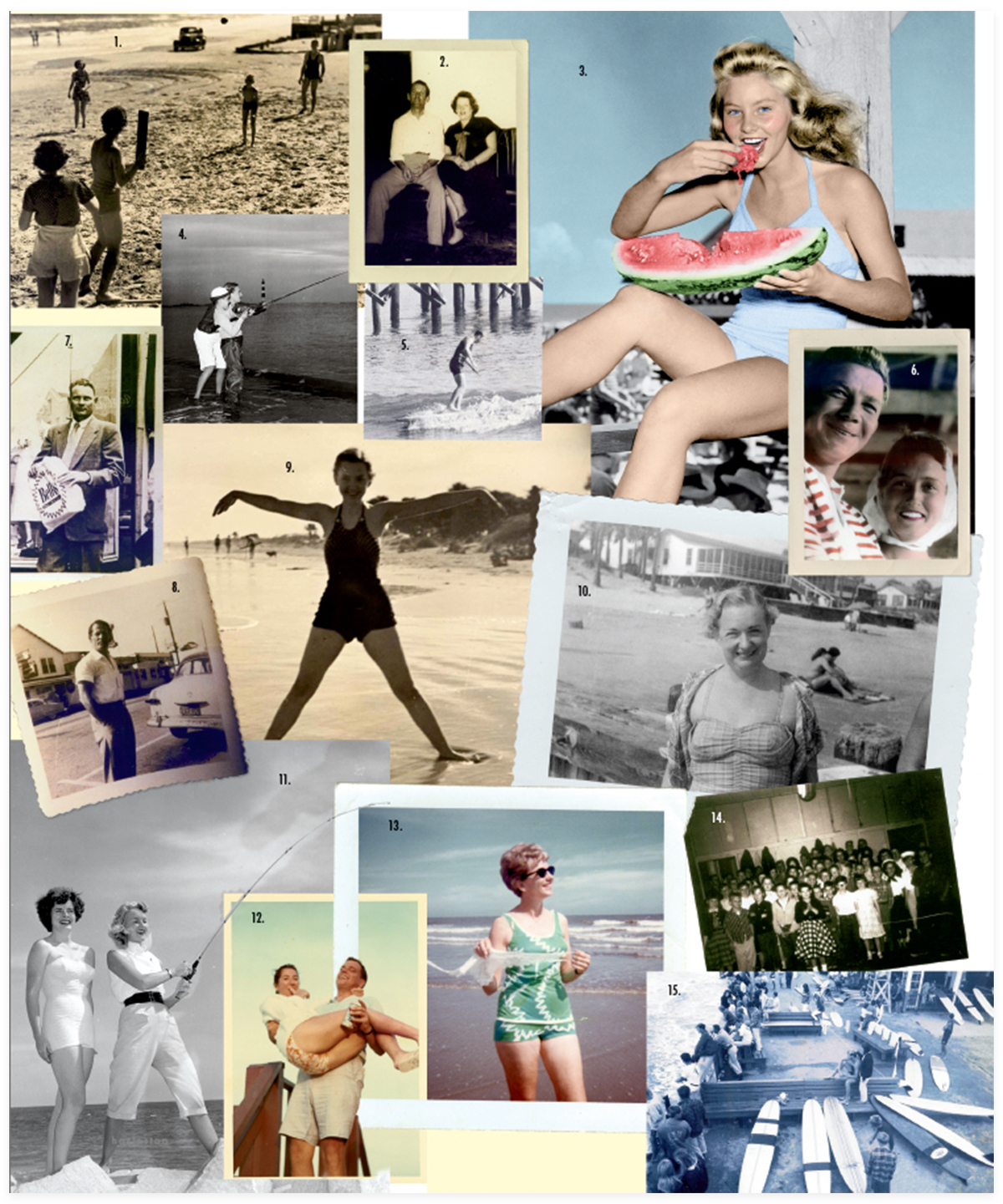
1. A makeshift softball game on the beach, circa 1940 (courtesy of The Charleston Museum); 2. Owners of Florence’s Drug Store, Boss and Florence Wilbanks (courtesy of Robert Knight); 3. Beauty contest winner Rachel Newton at a Folly Beach Chamber of Commerce picnic in 1946 (courtesy of South Carolina Historical Society); 4. Eileen Reilly and Robert Lockwood surf fishing on the east end of the island, circa 1960 (courtesy of South Carolina Historical Society); 5. Ted McKevlin surfing near the pier in 1968 (courtesy of Tim McKevlin); 6. Robert Knight and his wife, Barbara; the couple met at a dance on the pier in May 1967 (courtesy of Robert Knight); 7. The Folly Beach bus driver waits to make another trip downtown, circa 1960 (courtesy of Robert Knight); 8. A man on Center Street in the 1960s (courtesy of Robert Knight); 9. A woman on the beach in the 1950s (courtesy of The Charleston Museum); 10. Elsie Jean Stamper Smith on the beach, circa 1957 (courtesy of Melinda Smith Monk); 11. “Miss Charleston” Florence Huxford casts into the surf while “Miss Azalea” Barbara Fowler looks on, circa 1960 (courtesy of South Carolina Historical Society); 12. Jackie Leer and Dick Bonds on the pavilion in the late 1960s (courtesy of Chris Thomas); 13. An unidentified beachgoer in the late 1960s (courtesy of Chris Thomas); 14. Local children in front of the Community Church in the 1940s (courtesy of Robert Knight); 15. Spectators watch one of the first surfing contests held at Folly in 1968 (courtesy of Tim McKevlin).
Famous and infamous, Folly has always been home to the creative and the colorful
Folly always has had a bohemian air, attracting those who advocated a laid-back lifestyle. Sullivan’s Island was too straight-laced for these carefree souls. Folly’s freewheeling ways attracted legions—it was a bastion for the nonconformists and remains so to this day.
Folly was also home to a somewhat cosmopolitan mixture. The Greek community exerted a strong influence. They ran many of the most prominent attractions on the island and invested heavily in real estate over the years. There was also a smattering of Jewish people, including the beloved lifeguard Jack Nathan, who strutted his physique near the pavilion. There were many Roman Catholics who built a charming church on Center Street. Folly was also home to retired folks who came from all over the country.
DuBose Heyward, perhaps Charleston’s most famous author of the 20th century, had a summer home on West Ashley Avenue. He called it “Follywood.” When George Gershwin stayed at Folly—where he wrote the music for Porgy and Bess in 1934 in a cottage on West Arctic—he often was entertained by Heyward and his family. Gershwin’s impression of Folly summed up much of the appeal of the strand. He said it reminded him of a battered South Sea island.
For a time, one of the FBI’s “10 Most Wanted” lived on Folly and was captured there in a rather spectacular manner right in the heart of town. Trigger Burke, whose real first name was Elmer, was wanted “for murder in New York, for the ambush-shooting in Boston of a Brinks robbery suspect, and for a sensational Boston jailbreak,” according to late Post & Courier columnist Frank Gilbreth.
Elizabeth O’Neill Verner often painted at Folly, as did other artists of her day, including Edward Hopper. There were countless others, including the late Sally Aimar, who summered at Folly for half a century. Sally, along with her pharmacist husband, Harold, was one of the most colorful and delightful of Folly’s residents. Sally not only enjoyed watercolors, she also took part in every facet of Folly life. She knew everyone on the island. She was a repository for facts and folklore. Together, they were part of Folly that slowly has slipped away. Most of the old-timers are gone now, and with them a trove of memories.